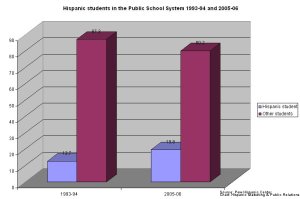Hispanic students have limited exposure to non Hispanic whites in public schools
Posted by Elena del Valle on November 6, 2007
Click on image to enlarge
Interaction between diverse groups of ethnic students may influence students’ attitudes and perhaps future behavior. How desegregated are public schools today? A recent analysis of 93,845 public school enrollment data by the Pew Hispanic Center revealed some interesting findings. The Center examined ethnic make up in public schools between 1993-94 and 2005-06 and discovered that while non Hispanic white students were less isolated from minority students black and Hispanic students became a little more isolated from non Hispanic white students.
The apparently contradictory statement can be explained, according to Rick Fry, a senior research associate at the Pew Hispanic Center and the author of the analysis, by looking at the overall demographic trends affecting schools during those years and how they affected the system. The report concludes that in nearly every state non Hispanic white students became more exposed to minority students since 1993-94. At the same time, in many states minority students are less exposed to non Hispanic white students.
His review indicates an increase of Hispanics in the public school system greater than 55 percent. In 2005-06, Latin students represented almost one fifth (19.8 percent) of public school students compared to 12.7 percent twelve years earlier.
“Latino Family Dynamics” audio recording


Brenda Hurley and Liria Barbosa
Discuss
- Latino purchasing habits and products they favor
- Latino family characteristics
- Latinos and extended families
- Division of duties, responsibilities within the family
- Who is the decision maker in the Latino family
- Who is the information provider in the Latino family
Click here to find out about Latino purchasing habits and “Latino Family Dynamics”
Because non Hispanic whites represent a lesser percent of students in public schools than in the past, they are more likely to come in contact with minority students. While in 1993-94, 34 percent of non Hispanic white students attended a nearly all-white school (according to the Pew report “nearly all-white” meant a school with less than 5 percent non-white students); by 2005-06, only 21 percent of non Hispanic white students was attending a nearly all-white school.
Today, minority students are less likely to be exposed to non Hispanic white students than in previous years. In 2005-06, 29 percent of Hispanic and 31 percent of black students attended nearly all-minority schools (Pew defines a “nearly all-minority” school as one in which fewer than 5 percent of the students are non Hispanic white). In 1993-94, 25 percent of Hispanic students and 28 percent of black students attended all-minority schools.
The researchers based their findings on data from the U.S. Department of Education Common Core of Data (CCD) Public School Universe Survey. The Pew Hispanic Center, an initiative of the Pew Research Center, is a non-partisan, non-advocacy research organization based in Washington, D.C. The Pew Hispanic Center is funded by The Pew Charitable Trusts.
Target Latinos effectively by anticipating changes in the market with
“Hispanic Projections with 2007-08 update” audio recording

Presenter Roger Selbert, Ph.D.
Find out
- About Latino buying power growth in the future
- How Latino market growth compares with other markets in the U.S.
- What drives the rise of Latino economic clout
- Who should target the Latino market
- What is the size of the Hispanic affluent market
- If the luxury Latino market is growing
Stay ahead of your competion with “Hispanic Projections”










